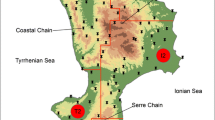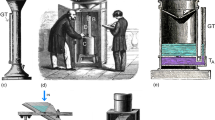Abstract
The Dry Day Since Last Rain index, DDSLR, quantifies for every recording day the number of consecutive preceding days with daily rainfall below a threshold. In essence, DDSLR may quantify the hydrologic stress generated by consecutive days of rainfall deficit taking into account some daily rainfall thresholds associated with the resolution of the pluviometer, evapotranspiration, runoff and thin layer saturation processes. A detailed analysis of DDSLR at daily and annual scales and for the whole recording period permits a complete description of the daily rainfall deficit regime and induced hydrologic stress. These characteristics have been derived for 0.1, 1.0, 5.0 and 10.0 mm/day thresholds for 93 years (1917–2009) of continuous daily rainfall records at the Fabra Observatory (Barcelona, NE Spain). Time trends on chronological series of DDSLR are determined and statistically tested for every calendar day. Fourier series analysis applied to four calendar day statistics (number of non-null DDSLR, average, standard deviation and maximum of DDSLR) leads to detection of the dominant periodicities, taking as fundamental periodicity the 365 days of the year. The best statistical model reproducing the empirical distribution of DDSLR, year by year, for every calendar day and for the whole recording period, is also investigated. Whatever the time scale considered, the Poisson-gamma model is assumed due to the non-negligible number of null DDSLR. Finally, time trends on extreme series of annual DDSLR, the appropriate statistical model for these series (the generalised logistic distribution, GLO), together with an estimation of DDSLR for several return periods, permit the description of the expected main future patterns of this index. In this way, current and next future hydrologic stress at the Fabra Observatory and neighbouring areas become characterised.

















Similar content being viewed by others
References
Aviad Y, Kutiel H, Lavee H (2009) Variation of the dry day since last rain, DDSLR, as a measure of dryness along a Mediterranean—arid transect. J Arids Environ 73:658–665
Benjamin JR, Cornell CA (1970) Probability, statistics and decision for civil engineers. McGraw-Hill, New York
Berger A, Goossens C (1983) Persistence of wet and dry days at Uccle (Belgium). J Climatol 3:21–34
Burgueño A, Serra C, Lana X (2004) Monthly and annual statistical distribution of daily rainfall at the Fabra Observatory (Barcelona, NE Spain) for the years 1917–1999. Theor Appl Climatol 77:57–75
Ceballos A, Schnabel S (1998) Hydrological behavior of a small catchment in the dehesa land use system (Extremadura, SE Spain). J Hydrol 210:146–160
Ceballos A, Martínez-Fernández J, Santos F, Alonso P (2002) Soil-water behaviour of sandy soils under semi-arid conditions in the Duero Basin (Spain). J Arid Environ 51:501–519
Coles S (2001) An introduction to statistical modelling of extreme values. Springer series in statistics, Springer, 208 pp
Douguedroit A (1987) The variation of dry spells in Marseilles from 1865 to 1984. J Climatol 7:541–551
Giorgi F, Lionello P (2008) Climate change projections for the Mediterranean region. Glob Planet Change 63(2–3):90–104
Hosking JRM, Wallis JR (1997) Regional frequency analysis. An approach based on L-moments. Cambridge University Press, 224 pp
Kendall S (1976) Time series, 2nd edn. Oxford University Press, New York, 198 pp
Kutiel H (1985) The multimodality of the rainfall course in Israel, as reflected by the distribution of dry spells. Arch Meteorol, Geophys Bioclimatol serie B 36:15–27
Lana X, Burgueño A (1998a) Daily dry–wet behaviour in Catalonia (NE Spain) from the viewpoint of first and second order Markov chains. Int J Climatol 18(7):793–815
Lana X, Burgueño A (1998b) Probabilities of repeated long dry episodes based on the Poisson distribution: an example for Catalonia (NE Spain). Theor Appl Climatol 60:111–120
Lana X, Burgueño A (2000) Some statistical characteristics of monthly and annual pluviometric irregularity for the Spanish Mediterranean coast. Theor Appl Climatol 65:79–98
Lana X, Serra C, Burgueño A (2003) Trends affecting pluviometric índices at the Fabra Observatory (Barcelona, NE Spain) from 1917 to 1999. Int J Climatol 23:315–332
Lana X, Martínez MD, Serra C, Burgueño A (2005) Periodicities and irregularities of indices describing the daily pluviometric regime of the Fabra Observatory (NE Spain) for the years 1917–1999. Theor Appl Climatol 82:183–198
Lana X, Burgueño A, Martínez MD, Serra C (2006a) Statistical distributions and sample strategies for the analysis of extreme dry spells in Catalonia (NE Spain). J Hydrology 324:94–114
Lana X, Martínez MD, Burgueño A, Serra C, Martín-Vide J, Gómez L (2006b) Distribution of long dry spells in the Iberian Peninsula, years 1951–1990. Int J Climatol 26:1992–2021
Lana X, Martínez MD, Burgueño A, Serra C (2008a) Return period maps of dry spells for Catalonia (NE Spain) based on the Weibull distribution. Hydrol Sci J 51:48–64
Lana X, Martínez MD, Burgueño A, Serra C, Martín-Vide J, Gómez L (2008b) Spatial and temporal patterns of dry spell lengths in the Iberian Peninsula for the second half of the 20th century. Theor Appl Climatol 91:99–116
Mariotti A, Dell’Aquila (2011) Decadal climate variability in the Mediterranean region: roles of large-scale forcing and regional processes. Clim Dyn DOI10.1007/s00382-011-1056-7-
Martínez-Murillo JF, Ruíz-Sinoga JD (2007) Seasonal changes in the hydrological and erosional response of a hillslope under dry-Mediterranean climatic condition (Montes de Málaga, SE Spain). Geomorphology 88:69–83
Martín-Vide J, Gómez L (1999) Regionalisation of peninsular Spain based on the length of dry spells. Int J Climatol 19:537–555
Öztürk A (1981) On the study of a probability distribution for precipitation totals. J Appl Climatol 20:1499–1505
Perzyna G (1994) Spatial and temporal characteristics of maximum dry spells in southern Norway. Int J Climatol 14:895–909
Reiser H, Kutiel H (2010) Rainfall uncertainty in the Mediterranean: dryness distribution. Theor Appl Climatol 100:123–135
Serra C, Burgueño A, Martínez MD, Lana X (2006) Trends in dry spells across Catalonia (NE Spain) during the second half of the 20th century. Theor Appl Climatol 85:165–183
Stern RD, Dennett MD, Dale IC (1982) Analysing daily rainfall measurements to give agronomically useful results (I). Direct methods. Exp Agric 18:223–236
Vicente-Serrano SM, Beguería M (2003) Estimating extreme dry-spell risk in the middle Ebro valley (NE Spain): a comparative analysis of partial duration series with a Pareto distribution and annual maximum series with a Gumbel distribution. Int J Climatol 23:1103–1118
Yair A, Lavee H (1985) Runoff generation in arid and semi-arid zones. In: Anderson MG, Burt TP (eds) Hydrological forecasting. Wiley, New York, pp 183–220
Zhang X, Zwiers FW, Li G (2004) Monte Carlo experiments on the detection of trends in extreme values. J Climate 17:1945–1952
Acknowledgements
The Reial Acadèmia de Ciències i Arts de Barcelona has kindly provided the time series of daily precipitation of the Fabra Observatory.
Author information
Authors and Affiliations
Corresponding author
Rights and permissions
About this article
Cite this article
Lana, X., Burgueño, A., Martínez, M.D. et al. Some characteristics of a daily rainfall deficit regime based on the Dry Day Since Last Rain index (DDSLR). Theor Appl Climatol 109, 153–174 (2012). https://doi.org/10.1007/s00704-011-0561-2
Received:
Accepted:
Published:
Issue Date:
DOI: https://doi.org/10.1007/s00704-011-0561-2




